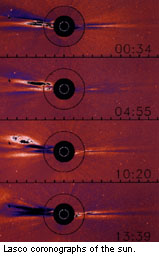Solar and Lunar Studies
SOLRAD/GRAB - NRL’s SOLar RADiation satellite program (SOLRAD) studied the Sun’s effects on Earth, over 11 missions.
The recently declassified Galactic Radiation and Background I (GRAB I) payload that flew with SOLRAD I, was America’s first operational intelligence satellite.
HRTS - NRL’s High Resolution Telescope and Spectrograph (HRTS) was a high-powered telescope that recorded ultraviolet spectra of the Sun on 10 shuttle flights and during the Space Shuttle Spacelab 2 mission in 1985.
SUSIM - NRL developed two Solar Ultraviolet Spectral Irradiance Monitor (SUSIM) instruments to study the Sun’s interaction with the upper earth atmosphere.
LASCO -  The Large Angle Spectrometric Coronagraph (LASCO) was developed for flight in 1995 on the Solar and Heliospheric Observatory (SOHO) to study coronal mass ejections, the hurricanes of space weather.
The Large Angle Spectrometric Coronagraph (LASCO) was developed for flight in 1995 on the Solar and Heliospheric Observatory (SOHO) to study coronal mass ejections, the hurricanes of space weather.
EIT - NRL developed this SOHO payload to understand the nature of the mechanisms that heat the corona to temperatures far higher than the Sun’s surface gases, and that drive the solar wind outward at speeds of more than a million miles per hour.
Clementine - Clementine was launched on January 25, 1994, to test lightweight miniature sensors and advanced spacecraft. Clementine also mapped the Moon between February 26 and April 22, and delivered more than 1.8 million digital images of the Moon back to the ground network. When scientists reviewed the data, they made a major scientific discovery: the possible existence of ice within some of the Moon�s craters. In 1994, President Clinton cited Clementine as one of the major national achievements in aeronautics in space.
